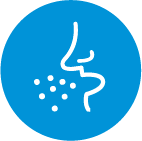

7 steps to tackling
children's allergy
This module will help keep you up to date on how to tackle allergy symptoms in children. Follow the module down the page and note the instructions as you go.
Objectives
- Understand the causes and symptoms of children's allergies
- Be able to confidently recommend Clarityn Allergy syrup (loratadine)
- Be able to advise parents with concerns about allergy on how to minimise contact with allergens
- Be aware of the signs of anaphylaxis
Did you know?
Allergic rhinitis affects as many as 4 in 10 children1
An allergic response can vary from being relatively mild to very severe (anaphylaxis) and parents may be seeking advice to manage symptoms experienced by their child.
Allergies, intolerances & sensitivities
An allergy occurs when the immune system perceives something as a threat (e.g. a food protein even after ingesting a small amount) and reacts, releasing histamine and other chemical mediators that result in symptoms such as a runny nose or itchy eyes. Common allergens include pollen, certain foods and dust mites.2, 3
An intolerance occurs when someone finds it difficult to digest particular foods and may have symptoms such as bloating or tummy pain, or a skin rash after eating the food. It is not life-threatening and doesn't involve the immune system. An example is lactose intolerance, where sufferers find it difficult to digest lactose.3, 4
A sensitivity is when someone is more sensitive to the effects of something, such as getting palpitations after drinking a caffeinated drink.3
Examples of causes of allergies3
Symptoms of allergy3
Symptoms of allergy include:


or blocked nose

may be watery

or coughing
A skin allergy can result in red, itchy skin or a rash.
Hives (also known as urticaria or nettle rash) are red, itchy bumps that can appear on the skin as a response to mediators such as histamine. Idiopathic urticaria is the term used when the cause is not known. Causes can include insect venom, animal dander (flakes of skin shed by animals), medicines such as penicillin, washing powders or latex.5
Children that are affected by eczema or asthma may find that an allergy exacerbates these conditions.3
Customers can purchase a range of products for children to help manage allergy symptoms including: oral antihistamines (such as loratadine); decongestants for a blocked nose; moisturising creams to reduce skin redness; topical antihistamine creams for insect bites/stings or nettle rash; anti-pruritic creams; nasal washes or barrier products to prevent contact with allergens.
Clarityn Allergy 1mg/ml Syrup (loratadine)
Mini quiz
Sammy is 4 years old and weighs 16kg.
What dose of loratadine syrup should he be given?
Incorrect, the dose for a child over two that weighs less than 30kg is 5ml once daily
Correct - Sammy weighs less than 30kg
Incorrect, the dose for a child over two that weighs less than 30kg is 5ml once daily


Reflection points
- Are you aware of different adrenaline auto-injectors and how they should be used?
- What advice would you give to help minimise exposure to pollen?
Now proceed to the next page to test your learning.
Clarityn Allergy 1mg/ml Syrup (loratadine) is indicated for the symptomatic treatment of allergic rhinitis and chronic idiopathic urticaria. Dosage and Administration: Adults and children over 12 years of age: 10ml (10mg) of syrup once daily. Children 2 to 12 years of age – Bodyweight more than 30kg: 10ml (10mg) of the syrup once daily. Bodyweight 30kg or less: 5ml (5mg) of the syrup once daily. Contraindications: Hypersensitivity to the active substances or to any other ingredients. Warnings and Precautions: Should be administered with caution in patients with severe liver impairment. Clarityn should be discontinued at least 48 hours before skin tests. Contains maltitol and sorbitol; thus patients with rare hereditary problems of fructose intolerance should not take this medicine. Side-effects: Hypersensitivity reactions (including angioedema and anaphylaxis), dizziness, convulsion, tachycardia, palpitation, nausea, dry mouth, gastritis, abnormal hepatic function, rash, alopecia and fatigue listed as very rare (< 1/10,000). In children (2 to 12 years of age), headache, nervousness and fatigue are listed as common (≥ 1/100 to < 1/1). Use in pregnancy and breast-feeding: Preferable to avoid during pregnancy. Clarityn should not be recommended during breast-feeding. RRP (Excl. VAT): 60ml£4.17. MA Number: PL 00010/0656. MA Holder: Bayer plc, 400 South Oak Way, Reading, RG2 6AD. Legal Category: GSL. Date of Preparation: December 2020.
1. Allergy prevalence: Useful facts and figures Allergy UK. Available at: https://www.allergyuk.org/information-and-advice/statistics
2. https://www.allergyuk.org/information-and-advice/conditions-and-symptoms/47-about-allergy
3. https://www.nhs.uk/conditions/allergies
4. https://www.nhs.uk/conditions/food-intolerance
5. https://www.ncbi.nlm.nih.gov/pmc/articles/PMC2492902
7. Medicines, Ethics and Practice (MEP), RPS July 2019
8. https://www.nhs.uk/conditions/allergies/prevention/
9. https://www.nhs.uk/conditions/anaphylaxis/
Online references last accessed February 2021.








